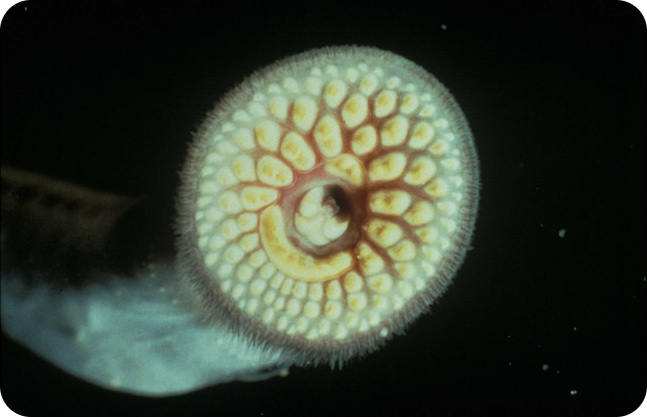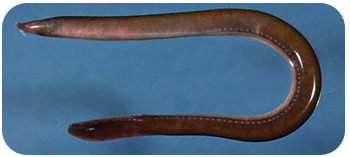10.4 Jawless Fish
10.4 Jawless Fish
What is this organism?
With this huge sucker lined with teeth, this organism might look like something out of science fiction. But this is a real fish found in the ocean, known as a lamprey. They use their teeth and sucker to bore into other fish and suck their blood. The lamprey is an example of a jawless fish.
Jawless Fish
What defines a jawless fish? You can probably guess. A jawless fish is a fish without a jaw. But there are other features that are shared by this class of organisms. Why would such an organism evolve? These fish were the first vertebrates to evolve. Logically, this makes sense, in that the vertebral column would evolve first, with the more complex jaw bones evolving later. The early jawless fish are thought to have relied on filter feeding to capture their food, and most likely would have sucked water and debris from the seafloor into their mouth, releasing water and waste out of their gills. As other sea life evolved, these jawless fish began to feed on other fish species, and are now considered a pest in their habitat. Lampreys have no natural predators.
Features of Jawless Fish
Jawless fish are missing the following parts:
- Jaws.
- Paired fins.
- A stomach.
Characteristics they do have include:
- A notochord, both in larvae and adults. Recall a notochord is a support rod that runs along the back of the fish.
- Seven or more paired gill pouches. These organs take dissolved oxygen from water.
- The branchial arches, a series of arches that support the gills of aquatic amphibians and fishes. They lie close to the body's surface.
- A light sensitive pineal eye, an eye-like structure that can detect light.
- A cartilaginous skeleton, a skeleton made of a flexible rubber-like supportive material called cartilage. This is similar to the skeleton of cartilaginous fish, which includes sharks and rays.
- A heart with two chambers.
- Reproduction using external fertilization.
- They are ectothermic. This means that their internal temperature depends on the temperature of their environment.
Classification of Jawless Fish
Most scientists agree that the jawless fish are part of the the superclass Agnatha. They belong to the phylum Chordata, subphylum Vertebrata. There are two living groups of jawless fish, with about 100 species in total: lampreys and hagfish (Figure below). Although hagfish belong to the subphylum Vertebrata, they do not technically have vertebrae (though they do have a skull), whereas lampreys do have vertebrae. For this reason, scientists still disagree on the classification of jawless fish.
A hagfish.
Summary
- The jawless fish include the lampreys and the hagfish.
- Jaws, fins, and stomachs are absent in the jawless fish.
- Features of the jawless fish include a notochord, paired gill pouches, a pineal eye, and a two-chambered heart.
Explore More
Use the resources below to answer the questions that follow.
- Invading Species Awareness PSA - Sea Lamprey at http://www.youtube.com/watch?v=x-KJZ22-wTQ (2:06)
- How do lamprey eat?
- How did lampreys reach the Great Lakes?
- What techniques are people using to try to control lampreys in the Great Lakes?
Review
- What are two examples of jawless fish?
- What are three characteristics of jawless fish?
- What is the pineal eye?
- Log in or register to post comments
- Email this page


